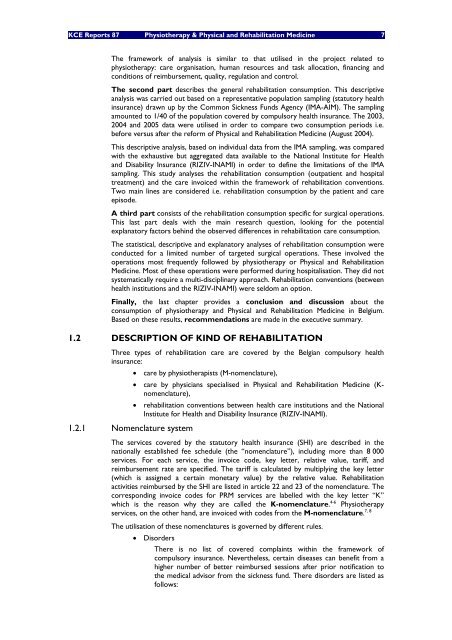Het gebruik van kinesitherapie en van fysische geneeskunde ... - KCE
Het gebruik van kinesitherapie en van fysische geneeskunde ... - KCE
Het gebruik van kinesitherapie en van fysische geneeskunde ... - KCE
You also want an ePaper? Increase the reach of your titles
YUMPU automatically turns print PDFs into web optimized ePapers that Google loves.
<strong>KCE</strong> Reports 87 Physiotherapy & Physical and Rehabilitation Medicine 7<br />
The framework of analysis is similar to that utilised in the project related to<br />
physiotherapy: care organisation, human resources and task allocation, financing and<br />
conditions of reimbursem<strong>en</strong>t, quality, regulation and control.<br />
The second part describes the g<strong>en</strong>eral rehabilitation consumption. This descriptive<br />
analysis was carried out based on a repres<strong>en</strong>tative population sampling (statutory health<br />
insurance) drawn up by the Common Sickness Funds Ag<strong>en</strong>cy (IMA-AIM). The sampling<br />
amounted to 1/40 of the population covered by compulsory health insurance. The 2003,<br />
2004 and 2005 data were utilised in order to compare two consumption periods i.e.<br />
before versus after the reform of Physical and Rehabilitation Medicine (August 2004).<br />
This descriptive analysis, based on individual data from the IMA sampling, was compared<br />
with the exhaustive but aggregated data available to the National Institute for Health<br />
and Disability Insurance (RIZIV-INAMI) in order to define the limitations of the IMA<br />
sampling. This study analyses the rehabilitation consumption (outpati<strong>en</strong>t and hospital<br />
treatm<strong>en</strong>t) and the care invoiced within the framework of rehabilitation conv<strong>en</strong>tions.<br />
Two main lines are considered i.e. rehabilitation consumption by the pati<strong>en</strong>t and care<br />
episode.<br />
A third part consists of the rehabilitation consumption specific for surgical operations.<br />
This last part deals with the main research question, looking for the pot<strong>en</strong>tial<br />
explanatory factors behind the observed differ<strong>en</strong>ces in rehabilitation care consumption.<br />
The statistical, descriptive and explanatory analyses of rehabilitation consumption were<br />
conducted for a limited number of targeted surgical operations. These involved the<br />
operations most frequ<strong>en</strong>tly followed by physiotherapy or Physical and Rehabilitation<br />
Medicine. Most of these operations were performed during hospitalisation. They did not<br />
systematically require a multi-disciplinary approach. Rehabilitation conv<strong>en</strong>tions (betwe<strong>en</strong><br />
health institutions and the RIZIV-INAMI) were seldom an option.<br />
Finally, the last chapter provides a conclusion and discussion about the<br />
consumption of physiotherapy and Physical and Rehabilitation Medicine in Belgium.<br />
Based on these results, recomm<strong>en</strong>dations are made in the executive summary.<br />
1.2 DESCRIPTION OF KIND OF REHABILITATION<br />
Three types of rehabilitation care are covered by the Belgian compulsory health<br />
insurance:<br />
• care by physiotherapists (M-nom<strong>en</strong>clature),<br />
• care by physicians specialised in Physical and Rehabilitation Medicine (Knom<strong>en</strong>clature),<br />
• rehabilitation conv<strong>en</strong>tions betwe<strong>en</strong> health care institutions and the National<br />
Institute for Health and Disability Insurance (RIZIV-INAMI).<br />
1.2.1 Nom<strong>en</strong>clature system<br />
The services covered by the statutory health insurance (SHI) are described in the<br />
nationally established fee schedule (the “nom<strong>en</strong>clature”), including more than 8 000<br />
services. For each service, the invoice code, key letter, relative value, tariff, and<br />
reimbursem<strong>en</strong>t rate are specified. The tariff is calculated by multiplying the key letter<br />
(which is assigned a certain monetary value) by the relative value. Rehabilitation<br />
activities reimbursed by the SHI are listed in article 22 and 23 of the nom<strong>en</strong>clature. The<br />
corresponding invoice codes for PRM services are labelled with the key letter “K”<br />
which is the reason why they are called the K-nom<strong>en</strong>clature. 4-6 Physiotherapy<br />
7, 8<br />
services, on the other hand, are invoiced with codes from the M-nom<strong>en</strong>clature.<br />
The utilisation of these nom<strong>en</strong>clatures is governed by differ<strong>en</strong>t rules.<br />
• Disorders<br />
There is no list of covered complaints within the framework of<br />
compulsory insurance. Nevertheless, certain diseases can b<strong>en</strong>efit from a<br />
higher number of better reimbursed sessions after prior notification to<br />
the medical advisor from the sickness fund. There disorders are listed as<br />
follows:

















